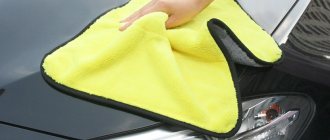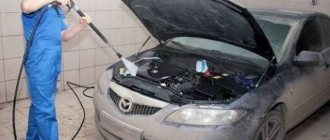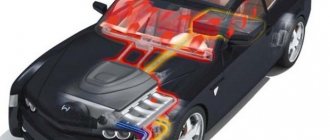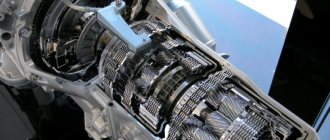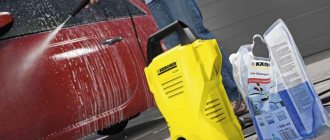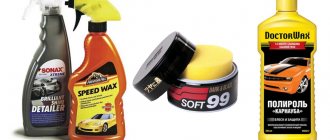Greetings to all! I prefer to wash my car myself. Having a private home has its advantages. But when I’m too lazy to do this, I use the services of car washes. Recently, a self-service car wash became a discovery for me. Initially I was skeptical, but after figuring it out a little, I still realized that this was a good solution. Why? This is exactly what I propose to talk about.
I will try to tell you about all the features of self-service car washes and how to use them correctly. The price is not that high, plus you choose the washing plan yourself. The cost of the procedure depends on the number of modes. But let's talk about everything in order.
How self-service car washes work
9 best high-pressure washers
Self-service car washes are gradually becoming a mandatory feature in the lives of Russian drivers.
Such stations have long been successfully used abroad. In our country they have not yet received due recognition.
Some domestic car enthusiasts are skeptical about this type of service or do not know how to use this equipment.
Such objects allow the car owner to wash his “swallow” the way he wants.
There is no mandatory program of actions that are performed at ordinary, professional car washes.
The car enthusiast is given complete freedom of action. It can save on car washing costs, as well as reduce or increase the time spent on such maintenance. This complex, a self-service car wash, is a set of blocks or posts in which one or another operating mode can be implemented.
In advance, at some complexes this is done upon completion of the wash, payment is made.
There are several options for depositing money for the service:
Example of payment for a self-service car wash.
- The station's cash desk, where the cashier will accept money or offer a terminal for payment.
- A machine that accepts banknotes.
- A device that accepts tokens that can be purchased from the same cashier or machine.
After this, the owner of the car washes it in the modes for which he paid money.
A separate post is equipment consisting, as a rule, of two spray guns connected to corresponding tanks with water and foamy liquid.
Based on the selected mode, they are supplied under a certain pressure: high or low.
Also, to remove complex types of contaminants, the sink has cleaning equipment with a brush, a device for finishing with wax, as well as a vacuum cleaner, which, together with the compressor, is located in a separate unit and a place for washing car mats.
Possible self-washing modes
Some car enthusiasts, especially older people, are afraid of the possible operation of technical equipment at a car wash.
There is nothing unclear or complicated about their maintenance. Such complexes are equipped with detailed instructions that describe the progress of work with this device.
An example of instructions for using a self-service car wash.
Let's list the modes operating in the posts/blocks of self-washing stations, and also talk about the functions they perform:
- Rinsing or, as this operation is sometimes called, technical washing. This mode is used by drivers who are in a hurry about their business, or by car enthusiasts who want to at least put their car in order in this way. The pressure of water coming out of the gun is 140 bar. In summer, cold water is supplied, in winter - warm water.
- Pre-wash. This rinsing mode with detergent is used when the machine is heavily dirty. This mode helps to pre-wet a thick layer of dried dirt before the main wash.
- Covering the car with foam. Here, the car is coated with a chemical detergent from car cosmetics for a short time (about two to three minutes), which allows it to dissolve the dirt and separate it from the body.
- Water + detergent. One of the main types of washing. Using this solution, under a pressure of about 150 bar, foam, dirt dissolved by auto chemicals, and complex deposits are washed off.
- Water + plus detergent + brush. The last component is attached to the spray gun body. The brush, interacting with water, removes “heavy” types of dirt. This mode should be used to clean the car from dirt in hard-to-reach places, as well as to process car wheels, tuning parts: linings, sills, etc.
- Final mode. It is produced for final rinsing and helps prevent the appearance of streaks and stains remaining from car cosmetics.
- Wax coating. This operation makes it possible to keep body parts clean for a long time, protecting them with its layer. Hydrophobic material repels road dirt and dust from the surface of the car.
- Air treatment. A compressed air spray gun helps remove moisture from your car door locks, preventing them from freezing in the winter. The air flow also cleans the side mirrors from water droplets and rubber products.
It should be noted that the quality of washing largely depends on the concentration and effectiveness of detergents and car cosmetics.
Setting the required proportions for effectively cleaning a car from mud deposits is the prerogative of the owners of such complexes.
Their attempts to save money on such additives leads to poor-quality washing, and the subsequent outflow of customers from this point.
Therefore, it is recommended to choose stations where the self-wash is equipped with the proper amount of detergents.
About money, time and savings
Self-service car wash is primarily interesting precisely because it saves money. A simple example - I have a KIA OPTIMA, a D-class car; to wash it at a regular car wash (just the body + mats) it costs about 200 - 250 rubles. If you take the body + mats + vacuum cleaner + wax it’s 450 – 550 rubles! NOT CHEAP!
On self-service, prices, as I wrote above, are several times lower! Again, a simple example: body + mats - ABOUT 50 rubles. Body + rugs + wax - about 100 rubles, but if you add a vacuum cleaner, about 150 - 200. It all depends on how efficient you are.
But “quickness” will come in handy. The whole point is that you throw in the money, turn on the sink (more details below), and off you go. That is, money has begun to be debited from your account; when it runs out, the car wash will stop. Thus, the faster you move around the car, the cheaper it will be for you. Otherwise, you can spend 100 rubles and not wash one side.
But as practice shows, even the slowest owners wash for no more than 100 rubles (this is the simplest option)
Step-by-step instructions for washing your car at a self-service car wash
Choosing a self-washing station becomes easier every year: the number of such stations is increasing.
A car enthusiast can choose a similar complex for himself, located near his home, based on the recommendations of his friends.
The washing process depends on:
- Availability of various washing stations at the station.
- Difficulties in vehicle contamination.
- Free time for the vehicle owner.
As a rule, information stands of the complexes tell about the steps of carrying out self-washing.
Failure to follow the order of steps can lead to poor cleaning of the machine from dirt.
The driver will not get the desired result and will waste money for such a service.
Let's look at how to properly wash a car at a self-service car wash.
Standard sequence
If a car owner decides to carry out a standard wash, and he has a sufficient amount of time for this, then he must perform the following operating modes:
1. First, a pre-wash is carried out, the process of soaking the car takes place. Depending on the degree of contamination of the vehicle, the car is rinsed with plain water or using detergent. In this way, mud layers are softened and body parts are wetted with liquid. 2. The car, prepared for the process, moves to the next post, where it is covered with foam of a car cosmetic preparation. After waiting a short time for its interaction with the mud surface to occur, the machine moves to the next station post.
3. At this stage, the car owner rinses the body. Water under pressure washes away foam and dirt and cleans the body.
4. Stage of applying liquid wax. The surface of the car is coated with a protective agent, which extends the life of a “clean car”. The wax coating also gives the vehicle a shine and improves its appearance.
5. The last step of the water procedures is the final washing of the body. Here excess wax is removed and final rinsing is performed. At reputable self-washing stations, demineralized (desalted) water is used at this stage, which helps to quickly dry body parts.
Reverse osmosis helps prevent the appearance of stains and dirt stains on the paintwork of the body, and its cloudiness.
6. The final stage of such work is treating locks, window openings, and other gaps with compressed air, as well as drying the car.
This mode must be used in winter. Otherwise, the remaining liquid may freeze, and it will be difficult for the owner to get into his car.
If the car owner is not satisfied with the result of the procedure after any of the stages, he can repeat it, of course, for an additional payment.
How to properly wash a car at a self-wash
Let us denote the sequence of correct actions when washing a car yourself:
- Removing and washing rubber floor mats for the interior and luggage compartment.
- Pre-rinse.
- The main stage of washing.
- A short break to blot mud deposits with foamy liquid.
- Rinsing, which in difficult cases can be replaced by an initial wash with a brush.
- Applying a protective wax layer.
- Final rinse.
This algorithm of actions helps to thoroughly clean the car from the most difficult contaminants.
Washing the rugs is the first step in the process that is performed initially. It is done using ordinary water and detergent.
After this, the rubber products are hung out in a specially designated place for drying. By the end of washing the car, they are practically dry.
An example of drying rugs.
What not to do at self-service car washes
Inexperienced car enthusiasts sometimes complain that they are not satisfied with the quality of such washing systems.
Upon detailed analysis of the actions performed, it turns out that in many ways they themselves are to blame.
Let's list the mistakes that motorists most often make when washing their cars at self-service stations:
- Failure to maintain the required distance from the spray gun to the paintwork of the vehicle. The spray bottle should be kept no closer than 30 cm from the car body parts. A shorter distance can damage the thin paintwork from the pressure of liquid escaping under high pressure.
- Treatment of damaged areas of the machine with a powerful stream of water. Here we mean areas with chips, scratches, pockets of corrosion, etc. The pressure here can also have a negative impact on surrounding parts, tear off paint, and expand the damage area.
- Cleaning contaminated areas with a rag or cloth. Such actions can lead to the fact that dirt that gets on the material becomes an abrasive material and damages the paint coating and damages the appearance of parts.
- Washing small car parts at an angle. Moldings, nameplates, and small tuning parts can fly off their seats under pressure.
- Thoroughly wipe the fresh wax coating with a cloth. Excessive efforts will be in vain; they may lead to the disappearance of the protective material. The money spent on it will be thrown away.
- Cleaning radiators under pressure at close range. The honeycombs of these parts become very dirty during movement. However, you can’t overdo your work here either. High water pressure can damage the structure of the device, which consists of thin elements.
- Washing a hot power plant with cold water. It should be noted that the “engine washing” function is not available on every complex of this type. If it is present, then such a procedure can lead to the formation of microcracks on the hot engine body and introduce changes in the structure of the metal, which can lead to costly repairs.
- High-pressure washing of engine compartment elements, especially fuel mixture intake parts: intake pipes, throttle, electrical circuit elements. Under the current, these parts can become faulty.
When using the services of a self-service car wash, you need to take into account the season in which this action is carried out.
Washing a car in summer differs from a similar operation carried out in winter.
Types of tariffs
Before using self-service car wash options, please consider the type of tariff:
- Per second. The most common option. After payment and mode selection, the timer starts. Time passes even when you are not using the equipment. This option is not suitable for beginners who cannot yet understand the principles of operation and, as a result, spend a large amount.
- Standard. Used in the 2010s, but today is almost never used. The essence of the method is to pay for the volume of water and detergent. This method is beneficial to car owners and allows them to spend more time at the car wash. The latter factor, in turn, leads to the appearance of queues.
- Differential. The price of a second changes depending on the selected option. In some cases, a certain amount is immediately charged for turning on the program.
Differences between car washing in summer and winter at independent stations
The cold winter season makes its own adjustments to the business of washing cars at self-service stations.
Let us list the main differences between both processes:
- The main difference is that washing a car requires cold water in summer and hot water in winter.
- Body parts heated by the sun in the summer must be cooled with cold water before starting maintenance. At near zero and sub-zero temperatures, on the contrary, you should rinse the car with warm water. Such methods protect the paintwork of cars from damage.
- In winter, the car requires more thorough washing, since not only dirt gets into various hard-to-reach places, but also chemicals that are generously scattered by road services. Poor washing will not allow you to wash away these substances that are harmful to metal car parts. As a result, they can cause the formation of corrosion foci at sites where paintwork is damaged.
- Summer dirt that sticks to the body, especially while driving on rural roads, is difficult to wash off. To do this, you have to make additional efforts: treat such places with a brush, increase the number of rinses.
- Car mats that are washed at the beginning of the process do not require wiping in the summer. They will already dry out from the warm temperature. In winter, the car enthusiast will have to work hard to remove water from their surface. Otherwise, the remaining moisture will become a source of condensation in the car interior, which will fog up the windows.
Let us describe in more detail the washing process itself in summer and winter.
Proper car washing at a self-service complex in summer
In summer, mud deposits are varied. This could be pollen and traces of encounters with unlucky flying insects, berry juice and herbal greens, etc.
During the summer season, when washing your car you have to follow certain rules:
- The car body, especially for dark-colored cars, heats up to a high temperature under the sun. Therefore, to cool it down, you should rinse it with cold liquid before washing. It can be plain water, or a combination of water + detergent;
- Do not cover a hot car with foam. It dries out quickly and loses its working qualities. You should also strictly adhere to the regulations for its application or even reduce the time it takes for the foam to soak into the dirt to 2 minutes.
- In the summer, it is necessary to wax the body parts, as well as carry out a final rinse. These modes will help protect the paintwork from dirt and make the car cleaner.
It should be noted that summer washing is more comfortable. Warm water cools quickly in winter, and when it comes into contact with a car enthusiast, it creates an unpleasant sensation.
Proper washing at a self-service complex in winter
Washing a car in winter has its own nuances that are different from summer.
It is recommended not to perform this procedure at temperatures below -7°C.
Moisture will get into the mechanisms, which will cause additional problems for the car owner. After treatment with water, the paintwork may be damaged by frozen drops. If the car needs to be washed, it is better to do it in a regular car wash in a heated room. Here service workers will professionally dry it.
Let's talk about other points that need to be taken into account when washing your car in the winter at a self-service station:
- A prerequisite for washing a car in winter is warm water.
- Carry out washing in complexes where there are heated zones.
- After arriving at the station, you must pause to warm up the body.
- You should thoroughly rinse the car, especially its lower part, cleaning it from chemical reagents and adhering snow dirt.
- It is imperative to use the mode of applying a wax coating to the surface, which will protect against ice and mud deposits.
- Another mandatory procedure is to blow air through the gaps and door locks.
A freshly washed car cannot be parked immediately for a long time. It should warm up for some time while driving.
Additional programs
Modern self-service car washes often use additional programs.
These include:
- “Osmosis” is water that has undergone special purification. Allows you to leave fewer spots/smudges on the surface after body treatment.
- “Hot water” is more effective at breaking down dirt. Particularly effective when washing a car at low temperatures.
- “Turbo drying” is the supply of warm air with a gun, which allows you to remove remaining water from the surface of the machine.
- “Insects” is a special “chemistry” designed to quickly dissolve various insects. It is easy to wash off to preserve the paintwork.
- "Wax". Provides for the application of a protective composition to the surface to protect the car from chips, stains and dirt.
- "Disks". A polish that cleans wheels and makes them shine.
Useful tips for saving money at self-service car washes
One of the main reasons for the popularity of such stations is their lower cost compared to classic car washes.
However, a car enthusiast can only benefit from the right actions.
We offer tips to help you save on such complexes:
- You should use the paid time rationally: you need to pick up the spray gun well in advance of starting the mode.
- To save time, washing car mats should be done near the place where they are dried.
- Before servicing, you need to stock up on small bills, which will allow you to economically pay for the services of using certain modes.
- During pauses, you can fill a bucket with water, take a sponge and manually walk through difficult stains. This will help avoid additional rinses.
- Don't use pauses too often. It takes time for the equipment to reach the required pressure.
- To extend the pause time, this trick is used. When the pause ends, you need to press a button for some mode, and then immediately turn on the “pause” button. In this case, no money will be charged.
- If the car owner regularly visits the car wash, then there is no need to use all modes. In this case, “waxing” or “pre-soaking” can be eliminated.
Each of the life hacks brings minor benefits. However, collectively they bring significant cost savings.
Mine!
We buy tokens from the machine and head to our cars. However, after throwing the first token into the washing machine, I remembered that I had forgotten to take out the rugs. Realizing that it would not be possible to do this after applying the foam, I decided that the first token would simply disappear. In real life, I would either refuse to wash the rugs at all, or take them out later and try to save time on other modes. In the current situation, I decided to do everything in order, took out the rugs, and “gifted” 2 rubles to the machine.
Since it was not yet hot outside in the morning, and the car had completely cooled down after standing in the box while we were filming the video, I decided to start washing with active foam. On the Internet they say that it should be applied with upward movements so that the foam acts longer in the most contaminated part of the body.
The car and floor mats are completely covered with foam. Taking my time so that it lasts longer, I go to the machine and throw the next token into it. The process of washing off the foam was not as simple as shown on the Internet. The foam is washed off from top to bottom. The reason is obvious: the foam flows down, to speed up the process you need to do everything in order.
I haven't really come to a definitive conclusion on whether to pay a lot of attention to this job or to quickly bypass the car and start applying wax. On the one hand, they write that wax is also supplied under pressure and extinguishes the activity of foam, on the other hand, that you should not apply it to unwashed areas of the body, where foam and dirt have not been washed off well, since the wax will cover them with a greasy film, wash them in the future will be more difficult. Based on this, I decided to wash off the foam as best as possible.
However, while I was trying to remove foam from the roof between the roof rails and from the hood, I realized that I had little time left and would not have time to wash the back of the car. In addition, the quality of the wash upset me. Since the next step was to apply wax, I believed that the car should be perfectly clean, and I did not expect to again see midges on its front, smudges near the handles and bitumen-like drops on the doors. So I decided to spend another coin and quickly apply some foam to the front of the car to wash away the bugs, and then switch to a water wash and wash the entire car, including the back and floor mats, which I didn't have time for.
This time there was enough time to wash the car, but its condition did not improve. Therefore, I decided to ask the employees for help, which is what I would have done if I had found myself in a similar situation with my car.
“If your car is not just dusty, but has specific contaminants in the form of midges, bitumen, grass and others, especially if you haven’t washed the car for a week, we would recommend that the client purchase a special product, apply it in advance on the street, and then drive into boxing and washing the car in the usual way,” explained Alexander Borovik. – We have the products on sale, usually a bottle lasts for a season. The same goes for washing discs. If the stains are fresh, I would advise the client to use the brush wash function. In any case, touchless washing will not be enough in your case.”
In a real situation, I think I wouldn’t use the brush right away, since the dirt is stale, and besides, I already spent an extra token on it. Most likely, I would act radically: I would buy a large bottle of the product, calmly wash off the midges, rinse the car and apply wax. And for the future I would have foreseen this moment in advance.
Now I decided not to buy the product, and in order not to leave the car dirty, the car wash employees simply wiped the problem areas, rinsed the car with water and gave me another token so that I could apply the wax and wash it off. The remaining two stages did not raise any questions. I managed to apply the wax in about a minute, after which I immediately decided to switch the device to demineralized water and better rinse the car in the remaining three minutes.
As a result, the entire process took us almost 30 minutes, of which the active phase lasted 12 minutes. We spent 12 rubles on washing, that is, we spent 4 rubles more than we planned.
Answers to frequently asked questions
Car enthusiasts ask questions about the peculiarities of the operation of such complexes.
Let's list those that are more common.
Can water pressure from a gun damage paintwork?
Maybe if the gun is brought close to the surface of the car at a distance of less than 30 cm.
Also, water coming out under high pressure can tear off the paint in places located next to damaged areas: chips, scratches, etc.
In other cases, you don’t have to worry about the condition of the car’s paintwork.
Is it necessary to use all available modes in a self-washing complex?
The driver himself chooses the modes and their number based on the degree of pollution of the car, his free time and finances.
How much time is spent on self-washing?
Having some experience in self-washing, a car enthusiast can spend about half an hour on it.
Of these, 10 minutes are spent on washing the car, the rest on drying. For a beginner, the time required for such procedures increases.
Is it possible to wash the engine in such complexes?
This option is not available at all stations. Where available, work must be carried out carefully, following the rules for washing engines.
Does it make sense to apply a wax coating to car windows?
You can apply wax to the glass filling of a car, but there is no point in doing so. The operation of windshield wipers and window lifts levels the processing result to the initial level.
Why do it yourself?
If you are a perfectionist and like everything to be done perfectly, then get ready that you will not be able to achieve the ideal quality of work on your own either the first or the second time. Well, or you will spend more time and money on this than if you turned to your usual washers. Professionals wash several dozen cars a day, they know how to work with different types of contaminants, they have more technical equipment and auto chemicals in their arsenal - most likely, the quality will be higher.
Also, washing your car yourself is not the most convenient option for putting things in order inside the car: you won’t find the necessary tools and “chemicals” for this at the car wash, at least for free, and it’s a bit dishonest to irritate the queue by rummaging around inside the car for a long time.
But this is a good option for those who do not need a perfectly polished car, but just need:
- remove dirt before visiting the service center
- deliver a relatively clean car to the client without spending a lot of time and money
- quickly wash away specific stains
Finally, there are people who fanatically protect their “swallow” from the touch of strangers. Let some incomprehensible and unfamiliar washer into the interior of your car? Yes, for such people it is like death, and in some ways I understand them. In the end, this is akin to meditation - you can spend time with your favorite car and enjoy the beauty you created with your own hands. Some kind of leak on the rear bumper is not a hindrance to this - alas, very soon road dirt and dust will stick to the car again.
